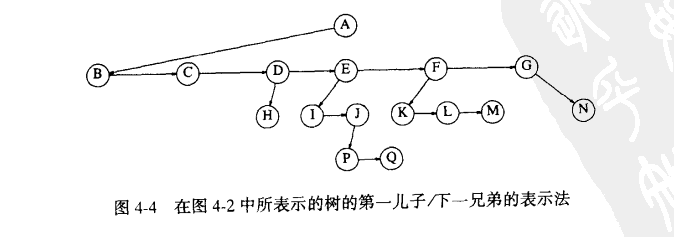树 [数据结构与算法分析 c 语言描述]
1. 树的概念
树就是一种非线性的数据结构,其平均复杂度为O(logN)。
2. 实现思路
- 只需要一个指向第一个节点的指针跟右侧兄弟节点的指针

3. 实现过程
定义树的结构体
typedef int element_type;
typedef struct node
{
element_type element;
struct node *first_child;
struct node *next_sibling;
} *tree;要实现的方法
tree create(element_type x);
void make_empty(tree t);
int is_empty(tree t);
void insert(element_type x, tree t, int is_child);
void print_tree(tree t);
void init(tree t); //初始化生成树手动输入
void rand_tree(tree t); //生成一个随机树4. 全部代码
#include <stdio.h>
#include <stdlib.h>
#include <time.h>
#define error(str) fatal_error(str)
#define fatal_error(str) fprintf(stderr, "%s\n", str),exit(1)
typedef int element_type;
typedef struct node
{
element_type element;
struct node *first_child;
struct node *next_sibling;
} *tree;
tree create(element_type x);
void make_empty(tree t);
int is_empty(tree t);
void insert(element_type x, tree t, int is_child);
void print_tree(tree t);
void init(tree t); //初始化生成树手动输入
void rand_tree(tree t); //生成一个随机树
void test();
void init(tree t)
{
tree temp_cell;
element_type x;
int has_child, has_sibling, is_leaf;
printf("has sibling node ?(1 or 0)\n");
scanf("%d", &has_sibling);
if (has_sibling == 1) {
printf("please input a intger as a tree node\n");
scanf("%d", &x);
temp_cell = (tree)malloc(sizeof(struct node));
temp_cell->element = x;
temp_cell->first_child = NULL;
temp_cell->next_sibling = NULL;
t->next_sibling = temp_cell;
init(temp_cell);
}
printf("has child node ?(1 or 0)\n");
scanf("%d", &has_child);
if (has_child == 1) {
printf("please input a intger as a tree node\n");
scanf("%d", &x);
temp_cell = (tree)malloc(sizeof(struct node));
temp_cell->element = x;
temp_cell->first_child = NULL;
temp_cell->next_sibling = NULL;
t->first_child = temp_cell;
init(temp_cell);
}
}
tree create(element_type x)
{
tree t;
t = (tree)malloc(sizeof(struct node));
if (NULL == t)
fatal_error("out of space");
t->first_child = NULL;
t->next_sibling = NULL;
t->element = x;
// init(t);
return t;
}
void make_empty(tree t)
{
//置空一个 tree
//递归调用每个节点销毁
if (NULL != t) {
make_empty(t->first_child);
make_empty(t->next_sibling);
free(t);
}
}
int is_empty(tree t)
{
return t == NULL;
}
// 插入做得比较简单
void insert(element_type x, tree t, int is_child)
{
tree temp_cell;
temp_cell = (tree)malloc(sizeof(struct node));
temp_cell->first_child = NULL;
temp_cell->next_sibling = NULL;
temp_cell->element = x;
//插那个节点,左插还是右插
if (t->first_child == NULL)
t->first_child = temp_cell;
else
t->next_sibling = temp_cell;
}
void rand_tree(tree t)
{
tree temp_cell;
static int hight = 0, width = 0, n = 1;
if (n <= 10) {
srand((unsigned)time(NULL));
if ( (rand() % 2) == 1 && n != 1 ) {
srand((unsigned)time(NULL) + hight + width);
temp_cell = (tree)malloc(sizeof(struct node));
temp_cell->first_child = NULL;
temp_cell->next_sibling = NULL;
temp_cell->element = rand() % 100 + 1;
t->next_sibling = temp_cell;
width++;
n++;
rand_tree(temp_cell);
}
if ( (rand() % 2) == 1 ) {
srand((unsigned)time(NULL) + hight + width);
temp_cell = (tree)malloc(sizeof(struct node));
temp_cell->first_child = NULL;
temp_cell->next_sibling = NULL;
temp_cell->element = rand() % 100 + 1;
t->first_child = temp_cell;
hight++;
width = 0;
n++;
rand_tree(temp_cell);
}
}
}
void print_tree(tree t)
{
if (NULL != t) {
printf("%d", t->element); //先序遍历 先节点
if (NULL != t->next_sibling)
printf("\t");
print_tree(t->next_sibling);
printf("%d", t->element); //中序遍历
if (NULL != t->first_child)
printf("\n");
print_tree(t->first_child);
printf("%d", t->element); //后序遍历
}
}
void test()
{
tree t;
t = create(1);
rand_tree(t);
print_tree(t);
}
int main(int argc, char const *argv[])
{
test();
return 0;
}本作品采用《CC 协议》,转载必须注明作者和本文链接





 关于 LearnKu
关于 LearnKu




推荐文章: